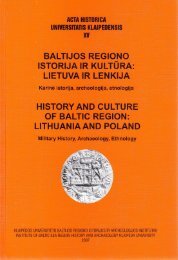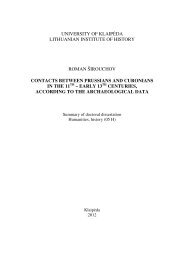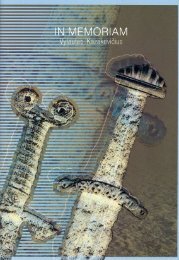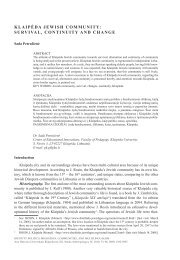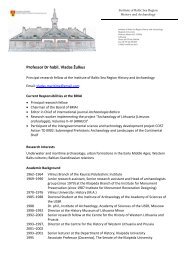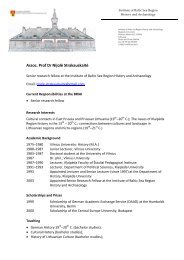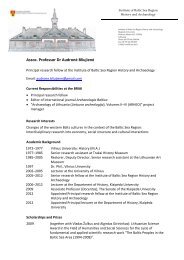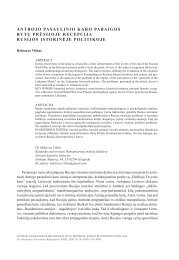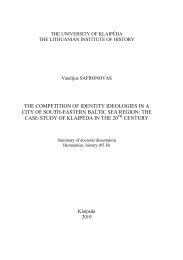See summary of dissertation in English - Baltijos regiono istorijos ir ...
See summary of dissertation in English - Baltijos regiono istorijos ir ...
See summary of dissertation in English - Baltijos regiono istorijos ir ...
Create successful ePaper yourself
Turn your PDF publications into a flip-book with our unique Google optimized e-Paper software.
In the 16 th century, the manors <strong>of</strong> East-Central Europe began the<br />
process <strong>of</strong> improvement <strong>of</strong> livestock breeds and started rais<strong>in</strong>g the<br />
cattle <strong>of</strong> Dutch breed. At that time, breed purity was not yet pursued <strong>in</strong><br />
Samogitia, but there were certa<strong>in</strong> attempts to improve the breed. A<br />
cow <strong>of</strong> Dutch breed was recorded <strong>in</strong> one <strong>of</strong> the manors, which could<br />
belong to large land-ownership, slightly earlier than the time established<br />
<strong>in</strong> historiography to this day. The calculation <strong>of</strong> the average<br />
number <strong>of</strong> cattle per manor revealed that the average number <strong>of</strong> cattle<br />
equaled to 17 cows per manor. Compared to other western areas <strong>of</strong> the<br />
Polish-Lithuanian Commonwealth, the differences <strong>in</strong> the number were<br />
rather trivial.<br />
Sheep breed<strong>in</strong>g prevailed among the breed<strong>in</strong>g <strong>of</strong> small livestock,<br />
which <strong>in</strong>cluded sheep, goats and pigs. The popularity <strong>of</strong> this branch <strong>of</strong><br />
farm<strong>in</strong>g was determ<strong>in</strong>ed by c<strong>ir</strong>cumstances: the arable lands abandoned<br />
at the times <strong>of</strong> war and covered with grass were excellent pastures for<br />
sheep. Little efforts and a comparatively low number <strong>of</strong> personnel<br />
sufficed for the<strong>ir</strong> ma<strong>in</strong>tenance. The popularity <strong>of</strong> sheep breed<strong>in</strong>g was<br />
also determ<strong>in</strong>ed by the demand for wool. Besides, not only meat and<br />
wool but also sheep milk was the product <strong>of</strong> consumption at that time.<br />
Sheep were kept at 32 farms <strong>of</strong> Samogitian manors, which accounted<br />
for 78% <strong>of</strong> all the farms, which <strong>in</strong>cluded records on livestock. The total<br />
number <strong>of</strong> sheep accounted for as much as 27% <strong>of</strong> all the livestock kept<br />
at the manors. The average number <strong>of</strong> this type <strong>of</strong> livestock per manor,<br />
which equaled to 12.8 units, and a rather even distribution <strong>of</strong> sheep kept<br />
at the manors (which most likely complied with the<strong>ir</strong> economic capacities)<br />
testify the important role <strong>of</strong> sheep at the farm.<br />
Sheep breed<strong>in</strong>g was followed by pig breed<strong>in</strong>g, which was the second<br />
most important type <strong>of</strong> small livestock kept at the farm. Pigs are<br />
mentioned <strong>in</strong> the <strong>in</strong>ventories <strong>of</strong> 34 manors, which make up 83% <strong>of</strong> all<br />
the manors <strong>in</strong>clud<strong>in</strong>g references to livestock. They accounted for 25%<br />
<strong>of</strong> the total number <strong>of</strong> livestock <strong>in</strong> the structure <strong>of</strong> Samogitian livestock<br />
farm<strong>in</strong>g. The average number <strong>of</strong> pigs per one economic object<br />
accounted for 10.8 units. Goats were least popular at the manor– they<br />
made up only 5% <strong>of</strong> all the livestock.<br />
32



